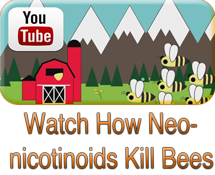20 November 2015 Field study: Neonicotinoid-treated oil seed rape harmful to honey bees at colony level
European governments have banned the use of three common neonicotinoid pesticides due to insufficiently identified risks to bees. This policy decision is controversial given the absence of clear consistency between toxicity assessments of those substances in the laboratory and in the field. Although laboratory trials report deleterious effects in honeybees at trace levels, field surveys reveal no decrease in the performance of honeybee colonies in the vicinity of treated fields. Here we provide the missing link, showing that individual honeybees near thiamethoxam-treated fields do indeed disappear at a faster rate, but the impact of this is buffered by the colonies' demographic regulation response. Although we could ascertain the exposure pathway of thiamethoxam residues from treated flowers to honeybee dietary nectar, we uncovered an unexpected pervasive co-occurrence of similar concentrations of imidacloprid, another neonicotinoid normally restricted to non-entomophilous crops in the study country. Thus, its origin and transfer pathways through the succession of annual crops need be elucidated to conveniently appraise the risks of combined neonicotinoid exposures. This study reconciles the conflicting laboratory and field toxicity assessments of neonicotinoids on honeybees and further highlights the difficulty in actually detecting non-intentional effects on the field through conventional risk assessment methods.
European governments have banned the use of three common neonicotinoid pesticides due to insufficiently identified risks to bees. This policy decision is controversial given the absence of clear consistency between toxicity assessments of those substances in the laboratory and in the field. Although laboratory trials report deleterious effects in honeybees at trace levels, field surveys reveal no decrease in the performance of honeybee colonies in the vicinity of treated fields. Here we provide the missing link, showing that individual honeybees near thiamethoxam-treated fields do indeed disappear at a faster rate, but the impact of this is buffered by the colonies' demographic regulation response. Although we could ascertain the exposure pathway of thiamethoxam residues from treated flowers to honeybee dietary nectar, we uncovered an unexpected pervasive co-occurrence of similar concentrations of imidacloprid, another neonicotinoid normally restricted to non-entomophilous crops in the study country. Thus, its origin and transfer pathways through the succession of annual crops need be elucidated to conveniently appraise the risks of combined neonicotinoid exposures. This study reconciles the conflicting laboratory and field toxicity assessments of neonicotinoids on honeybees and further highlights the difficulty in actually detecting non-intentional effects on the field through conventional risk assessment methods.

